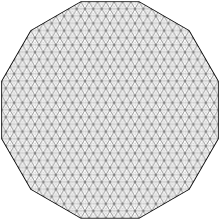Eternity puzzle

Eternity is a tiling puzzle created by Christopher Monckton and launched by the Ertl Company in June 1999. Consisting of 209 pieces, it was marketed as being practically unsolveable, with a £1 million prize on offer for whoever could solve it within four years. The prize was paid out in October 2000 for a winning solution arrived at by two mathematicians from Cambridge.[1] A second puzzle, Eternity II, was launched in Summer 2007 with a prize of US$2 million.[2]
Puzzle
The puzzle's scope was to fill a large almost regular dodecagon with 209 irregularly shaped smaller polygon pieces of the same color. All the pieces were made from a combination of equilateral triangles and half-triangles, with each piece having the same total area of 6 of those triangles, and between seven and eleven sides.[1][3]
Retail
The puzzle was launched in June 1999, by Ertl, marketed to puzzle enthusiasts and 500,000 copies were sold worldwide, with the game becoming a craze at one point. Eternity was the best-selling puzzle or game in the UK at its price-point of £35 in the month it was launched.
Prize
The puzzle's inventor Christopher Monckton put up half the prize money himself, the other half being put up by underwriters in the London insurance market. According to Eternity's rules, possible solutions to the puzzle would be received by mail on September 21, 2000. If no correct solutions were opened, the mail for the next year would be kept until September 30, 2001, the process being repeated every year until 2003, after which no entries would be accepted.
Before marketing the puzzle, Monckton had thought that it would take at least three years before anyone could crack the puzzle.[1] One estimate made at the time stated that the puzzle had 10500 possible attempts at a solution, and it would take longer than the lifetime of the Universe to calculate all of them even if you had a million computers.[4]
Once solved, Monckton claimed that the earlier-than-expected solution had forced him to sell his 67-room house, Crimonmogate, to pay the prize.[1][2] In 2006, he said that the claim had been a PR stunt to boost sales over Christmas, that the house's sale was unrelated to the prize as he was going to sell it anyway.[2]
Solution
As soon as the puzzle was launched, an online community emerged devoted to solving it, centred on a mailing list[5] on which many ideas and techniques were discussed. It was soon realised that it was trivial to fill the board almost completely, to an "end-game position" where an irregularly-shaped void had to be filled with only a few pieces, at which point the pieces left would be the "wrong shapes" to fill the remaining space. The hope of solving the end-game depended vitally on having pieces that were easy to tile together in a variety of shapes. Computer searches were carried out to find which pieces tiled well or badly, and these data used to alter otherwise-standard backtracking search programs to use the bad pieces first, in the hope of being left with only good pieces in the hard final part of the search.
The puzzle was solved on May 15, 2000, before the first deadline, by two Cambridge mathematicians, Alex Selby and Oliver Riordan.[6] Key to their success was the mathematical rigour with which they approached the problem of determining the tileability of individual pieces and of empty regions within the board. These provided measures of the probability that a given piece could help to fill or 'tile' a given region, and the probability that a given region could be tiled by some combination of pieces. In the search for a solution, these probabilities were used to identify which partial tilings, out of a vast number explored by the computer program, were most likely to lead to a solution. A complete solution was obtained within seven months of development with the aid of two domestic PCs.
Although not required for the prize, a complete solution with at least one of the six hint pieces correctly placed has not yet been discovered. The first hint, which was shown placed on every board and solution sheet, was not required to be placed there in any solution submission for the prize. The other five hints could be obtained after submission of solutions to the three clue puzzles. Without any fixed hint pieces required, the puzzle was significantly easier to solve. However, currently there are no known complete solutions with all of the six hint pieces fixed in the correct positions.
Inspirations
The architectural design of the Perth Arena in Perth, Western Australia was heavily influenced by the eternity puzzle; the exterior design is also strongly reflected throughout the main arena, foyers, breakout function rooms and the entrance to the venue.[7]
References
- 1 2 3 4 "£1m Eternity jackpot scooped", BBC News, 2000-10-26
- 1 2 3 "Aristocrat admits tale of lost home was stunt to boost puzzle sales". The Scotsman. 2007-01-24. Retrieved 2007-01-24.
- ↑ Prize specimens | plus.maths.org
- ↑ Duncan Richer (July 1999), The Eternity Puzzle, NRICH
- ↑ "Eternity mailing list". Retrieved 2011-09-28.
- ↑ "Description of (Eternity solver) method". Alex Selby (and Oliver Riordan). 2007-06-16. Retrieved 2007-06-16.
- ↑ "Ashton Raggatt McDougall turn to colour for Perth Arena". Architecture & Design. Retrieved 18 May 2012.
External links
- A detailed article on how the puzzle was solved
- Discussion of the Eternity puzzle and related problems
- Alex Selby's page on the Eternity puzzle
- Wolfram MathWorld article